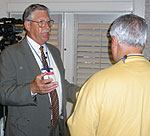
Klarberg and Proctor pointed out some of the benefits of a retirement plan, including reducing personal taxes, saving for a plan using pretax dollars, growing savings on a tax-deferred basis, and receiving a business tax deduction for having a plan with employer contributions. All points lead to attracting and keeping good employees.
But despite the benefits and the need for an employer-contributed retirement plan, some employees simply don't think they need a plan, according to Klarberg. He said that a recent survey showed that 34 percent of workers are not worried about having enough money for retirement. "It is unbelievable how some people can be optimistic about having enough for retirement."
Yet despite apathetic employees, employers should make every effort to show the benefits of tax deferred savings while they are getting valuable tax deductions for their businesses.
FACTORS TO CONSIDER
Klarberg said there are three things to consider when saving for retirement:1. The value of starting early.
2. The effect of inflation.
3. The importance of tax-deferred saving.
"The sooner you start saving, the more significant the savings will be over an extended period of time," he said.
The current life expectancy rate has created a couple of different dynamics. The aging population has more people receiving benefits than those who are contributing to the benefit plan. And people are actually spending more time in retirement than they spent working. "Are you prepared to finance your retirement if you are retired more years than you work?" he asked the seminar attendees.
Klarberg pointed out the example of how inflation and taxes have negative effects on investments. Using a $10,000 investment with a 4 percent interest rate gives a return of $400 per year. An inflation rate of 2.3 percent on the $10,000 reduces the $400 by $230 to $170. Taxes on the $10,000 would be an estimated $112, which subtracted from $170 leaves a balance of $58 after taxes and inflation, or a 0.58 percent return on investment.
"As you look at ways to accumulate dollars you have to factor in taxes and a realistic inflation rate," Klarberg said.
As people are working longer, past the normal age for mandatory withdrawal of retirement plan money, there are ways to delay the disbursement of funds, including rolling over the money into an Individual Retirement Account (IRA) without paying a tax penalty.
Klarberg talked about two types of IRAs: traditional and Roth. The traditional IRAs are funded with pretax dollars. Roth IRAs use money that is taxed when added to the plan but is never taxed again after that.

RETIREMENT PLANS DEFINED
Proctor told attendees, "No matter what your company looks like, there is a retirement plan for you. She explained that simple IRAs are plans for companies with a maximum of 100 employees, each with at least $5,000 in compensation, and are best suited for employers who want to encourage retirement savings and avoid administration costs.In an IRA, an employer must make a tax-deductible contribution using one of the formulas:
Employees can contribute up to $10,000 annually and there is also a "catch-up" provision in 2006 where an additional $2,500 can be added. "And as an employer, you are also considered an employee and can put aside the same amounts for yourself," Proctor said.
She also described simplified employee pension plans (SEP), saying these are better suited for smaller shops. SEP plans are best suited for business owners who want simplicity, companies with volatile profits and low employee turnover, and have company contributions only.
Popular 401(k) programs include an owners-only plan, which Proctor said is "mainly for mom and pop shops. This is the greatest vehicle for putting away the maximum amount of money."
Under this plan, employers can contribute up to 25 percent of their income, use an additional employee deferral amount, and take advantage of a "catch-up" feature.
She also talked about Safe Harbor 401(k) plans, which offer a solution for "those who wish to accumulate substantial retirement income and maximize the benefit to the key employees/owners." These plans allow owners and employees to make pre-tax salary deferral contributions up to $15,000 of compensation.
Proctor said that most of her clients use the Safe Harbor plan featuring a nonelective contribution, where the employer will provide a minimum of 3 percent Safe Harbor contribution to all eligible employees regardless of their participation in the plan.
Proctor and Klarberg pointed out that employers benefit when employees are explained the benefits of a retirement plan because it allows employees to make better financial decisions, have more confidence in making decisions, and improve their financial situations.
"Not only are you empowering your employees but now you are helping them make sound financial decisions," Proctor said.
Publication date: 03/27/2006

Report Abusive Comment